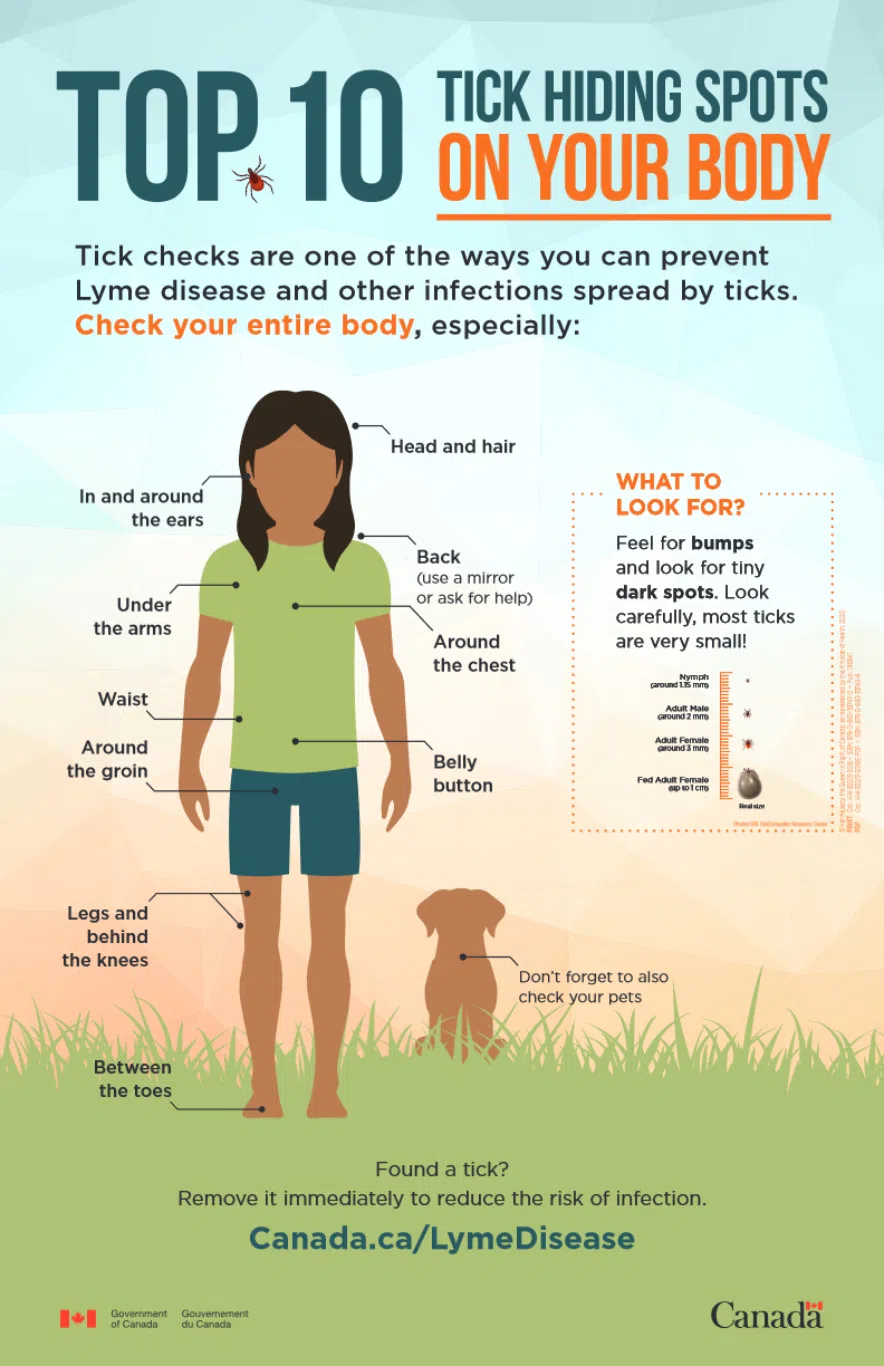Ticks are common in Saskatchewan in spring and summer, but there are some simple things people can do to minimize their risk of being bitten, and also deal with tick bites when they occur.
David Torr, SHA medical officer, says Lyme disease is the biggest threat carried by the small parasitic arachnid.
“If you’ve seen a tick, it’s really important to take a picture of that tick and keep that tick until you’ve had an identification of it and send the photo to etick.ca,” Torr said.
“That’s a really fast way of identifying the tick for you and telling you whether it’s very common dog tick or whether it’s actually the more risky tick that can cause Lyme disease.”
Torr says that black-legged ticks carry a higher risk of Lyme disease and while there aren’t many in Saskatchewan, their numbers have been growing over the years.
Since 2008, almost 38,000 ticks have been identified through voluntary submission to etick, and about 150 of them were black-legged ticks, according to Torr.

The top 10 tick hiding spots on your body.(Government of Canada)
What can I do to stop tick bites?
- Wear light-coloured clothes so ticks can be easily seen.
- Wear pants, long-sleeved shirts, and closed toe shoes that do not expose your bare feet.
- Pull socks over your pant legs to prevent ticks from crawling up your legs.
- Use insect repellents that contain DEET or Icaridin. Apply repellent to clothes as well as your skin. Always read and follow the directions on the label. Some repellents may have age restrictions.
- In Canada, clothing that has been treated with the insecticide permethrin has been approved for use by people over the age of 16.
- Shower or bathe as soon as possible after being outside to wash off loose ticks and inspect for attached ticks.
“These ticks can sometimes hide very easily within the hair or just behind the ear. They move quite rapidly and they are quite small,” Torr said.
He also said people should check their pets as well.
Torr said symptoms for Lyme disease can vary quite a bit from person to person.
“You can have symptoms presenting much, much later — a couple of weeks later or a few days (after getting bitten),” he said.
“… You might feel cold or a bit feverish but very typically you will see a site that is the characteristic bullseye on the skin, but that can be hard to see in some skin textures.”
The SHA says people should monitor for signs of Lyme disease by checking for that “bulls-eye” rash. Other symptoms include fever, chills, headache, fatigue, muscle and joint aches, and swollen lymph nodes.
It is recommended that people consult a physician immediately if they develop symptoms suggestive of Lyme disease after a tick bite. If untreated, Lyme disease may affect the joints, the heart, and nervous system.
Health Canada recommends that when people are outdoors they should:
- Walk on cleared paths or trails.
- Keep children and pets from wandering off paths.
- Avoid using trails created by animals (such as deer and moose), as ticks are often found on the grass and plants along these trails.
Once back indoors, Health Canada recommends people:
- Do a full-body tick check on yourself, children, pets, and persons in your care.
- Shower as soon as possible, as it can help wash off unattached ticks
- Check clothes for ticks and put dry clothes in a dryer on high heat for at least 10 minutes or if longer your clothes are damp.
- Wash your clothes in hot water. Ticks can survive a cold or warm wash cycle.
How do I remove a tick?
Health Canada recommends removing attached ticks as soon as possible to reduce the chance of infection.
If you find an attached tick:
- Use clean, fine-point tweezers to grasp the head as close to the skin as possible and slowly pull straight out.
- Try not to twist or squeeze the tick. Ticks firmly attach their mouthparts into the skin requiring slow but firm traction to remove them.
- If the mouthparts break off and remain in the skin, remove them with the tweezers. If you’re unable to remove them easily, leave them alone and let the skin heal.
- Wash the bite area with soap and water or an alcohol-based sanitizer.
Do not try to remove the tick by burning it or smothering it with nail polish, essential oils, petroleum jelly or nail polish remover. This can cause the tick to release its stomach contents, which can be infected, into the bite area, according to Health Canada.
How to disposing of a tick
Health Canada says people should kill a tick before disposing of it by drowning it in rubbing alcohol or by freezing it for several days.
Avoid squashing ticks with bare fingers as infection may enter through breaks in the skin, such as close to a fingernail.
You can dispose of ticks in your household garbage once they’re dead, they say.

Pets can bring ticks into your yard or home. Talk to a veterinarian about tick prevention. (Bigandt / Depositphotos.com)
How to reduce ticks around your home
Ticks can also be found around your home. They can’t survive for long in dry, sunny areas and are often found in and near areas with trees, shrubs, grass, wood piles or piles of leaves.
To reduce ticks around your home, create an environment where ticks can’t survive by:
- Mowing the lawn often to keep the grass short.
- Removing piles of leaves, tree brush, long grass, and weeds at the edge of the lawn and around stone walls and wood piles.
- Pruning shrubs and trees to allow sunlight to filter through.
- Creating a wood chip, mulch or gravel border that is at least 1-metre wide between your lawn and shrubs, stone walls or forested areas.
- Sealing stone walls and other openings to help prevent animals such as deer, mice and other rodents from bringing ticks into your yard.
- Placing patios, decks and children’s playground sets in sunny areas of the yard and away from yard edges.
- Placing playground sets on a wood chip or mulch surface.
— with files from 980 CJME’s Daniel Reech and CKOM News
Read more:











